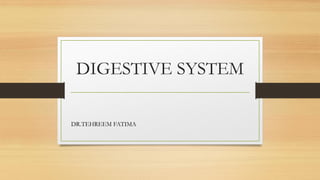DIGESTIVE SYSTEM BY DR. TEHREEM FATIMA.pdf
•
0 j'aime•7 vues
detail about human digestive system
Signaler
Partager
Signaler
Partager

Recommandé
Recommandé
More than Just Lines on a Map: Best Practices for U.S Bike Routes
This session highlights best practices and lessons learned for U.S. Bike Route System designation, as well as how and why these routes should be integrated into bicycle planning at the local and regional level.
Presenters:
Presenter: Kevin Luecke Toole Design Group
Co-Presenter: Virginia Sullivan Adventure Cycling AssociationMore than Just Lines on a Map: Best Practices for U.S Bike Routes

More than Just Lines on a Map: Best Practices for U.S Bike RoutesProject for Public Spaces & National Center for Biking and Walking
Contenu connexe
En vedette
More than Just Lines on a Map: Best Practices for U.S Bike Routes
This session highlights best practices and lessons learned for U.S. Bike Route System designation, as well as how and why these routes should be integrated into bicycle planning at the local and regional level.
Presenters:
Presenter: Kevin Luecke Toole Design Group
Co-Presenter: Virginia Sullivan Adventure Cycling AssociationMore than Just Lines on a Map: Best Practices for U.S Bike Routes

More than Just Lines on a Map: Best Practices for U.S Bike RoutesProject for Public Spaces & National Center for Biking and Walking
En vedette (20)
How to Prepare For a Successful Job Search for 2024

How to Prepare For a Successful Job Search for 2024
Social Media Marketing Trends 2024 // The Global Indie Insights

Social Media Marketing Trends 2024 // The Global Indie Insights
Trends In Paid Search: Navigating The Digital Landscape In 2024

Trends In Paid Search: Navigating The Digital Landscape In 2024
5 Public speaking tips from TED - Visualized summary

5 Public speaking tips from TED - Visualized summary
Google's Just Not That Into You: Understanding Core Updates & Search Intent

Google's Just Not That Into You: Understanding Core Updates & Search Intent
The six step guide to practical project management

The six step guide to practical project management
Beginners Guide to TikTok for Search - Rachel Pearson - We are Tilt __ Bright...

Beginners Guide to TikTok for Search - Rachel Pearson - We are Tilt __ Bright...
Unlocking the Power of ChatGPT and AI in Testing - A Real-World Look, present...

Unlocking the Power of ChatGPT and AI in Testing - A Real-World Look, present...
More than Just Lines on a Map: Best Practices for U.S Bike Routes

More than Just Lines on a Map: Best Practices for U.S Bike Routes
Ride the Storm: Navigating Through Unstable Periods / Katerina Rudko (Belka G...

Ride the Storm: Navigating Through Unstable Periods / Katerina Rudko (Belka G...
Good Stuff Happens in 1:1 Meetings: Why you need them and how to do them well

Good Stuff Happens in 1:1 Meetings: Why you need them and how to do them well
DIGESTIVE SYSTEM BY DR. TEHREEM FATIMA.pdf
- 3. INTRODUCTION: • The digestive system consists of gastrointestinal tract. • The accessory organ of digestion is Tongue, salivary glands, pancreas, liver and gallbladder. • It helps to breakdown complex food into smaller and simplest form. • The process of digestion consists of three stages 1. Cephalic phase 2. Gastric phase 3. Intestinal phase
- 4. 1. CEPHALIC PHASE: • Cephalic means is ( related to head). • The first phase of digestive system beings with the secretions from gastric glands. • In response to the sight and smell of food. • It includes the mechanical breakdown of food by chewing, and the chemical breakdown by digestive enzymes, that take place in mouth. • Saliva consists of digestive enzymes amylase and lingual lipase, secreted by the salivary and serous glands on the tongue. • The chewing is the mechanical process that mix the saliva with food. • This produce a bolus which is swallowed down the esophagus to enter the stomach.
- 6. 2. GASTRIC PHASE: • The second stage of digestive begins in the stomach with gastric phase. • Here the food is further broken down by mixing with gastric acid( present in stomach). • And then passes into the duodenum, the first part of the small intestine. • The digestive enzymes including gastrin converts the food into thick semiliquid substance called chyme.
- 7. 3. INTESTINAL PHASE: • It begins in the duodenum. • Here the food partially digested and mixed with the number of enzymes produced by the pancreas like bile juice etc. • Digestion is helped by the chewing of food carried out by the muscle of mastication, the tongue, the teeth and segmentation. • Gastric acid and the production of mucus in the stomach, are essential for the continuation of digestion. • Peristalsis is the rhythmic contraction of the muscle that begins in the esophagus and continues along the wall of the stomach and the rest of the gastrointestinal tract.
- 8. Continue….. • Chyme which when fully broken down in the small intestine is absorbed as chyle into the lymphatic system. • The indigestive food goes into the large intestine where no digestion and absorption take place. • Just water and some minerals are reabsorbed back into the blood in the colon of the large intestine. • The waste products of digestion (feces) are defecated from the rectum via the anus.
- 9. THANK YOU